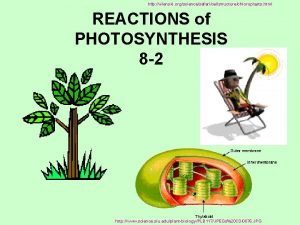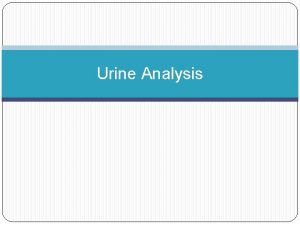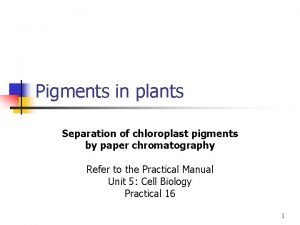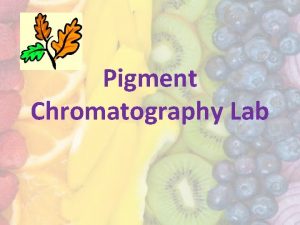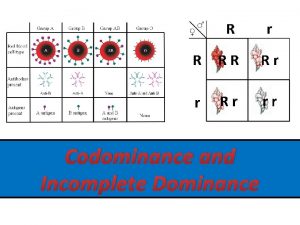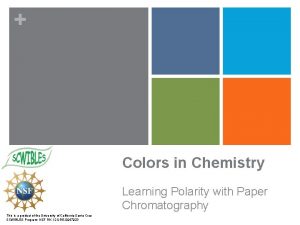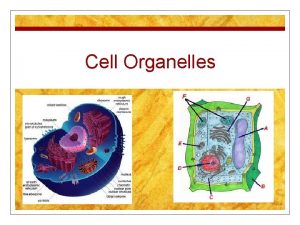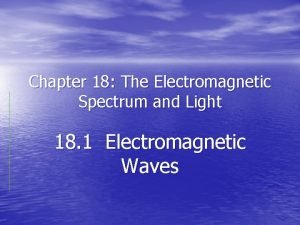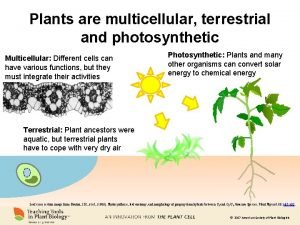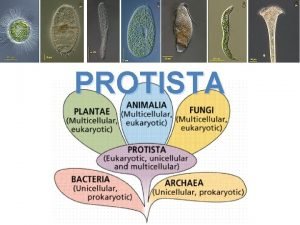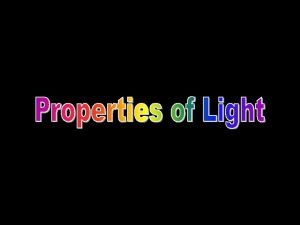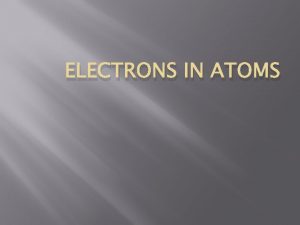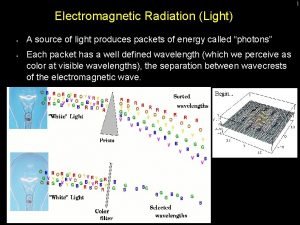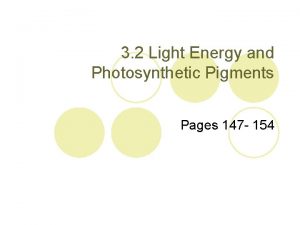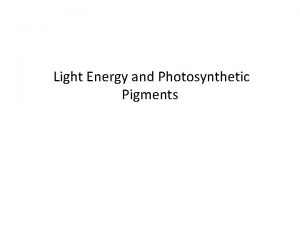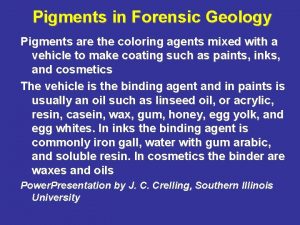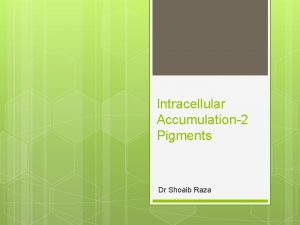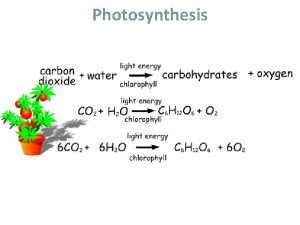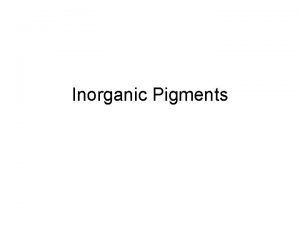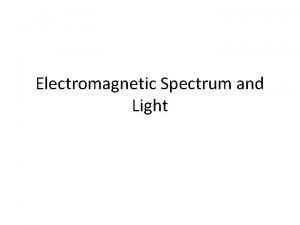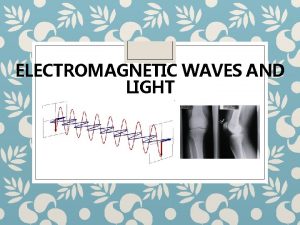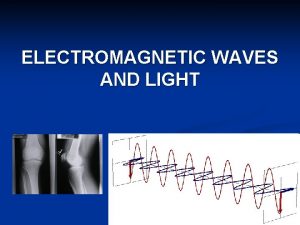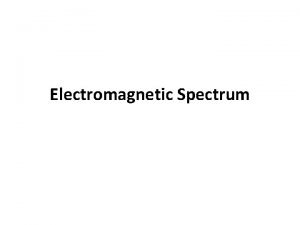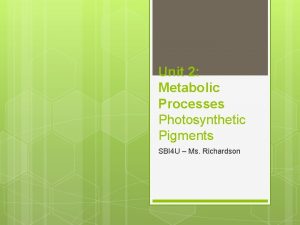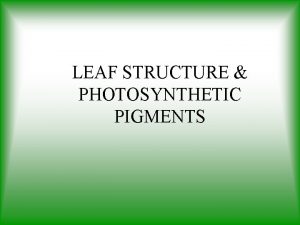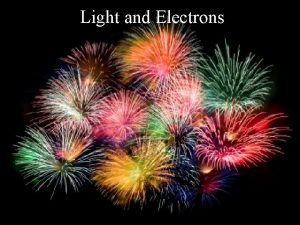Light Energy Photosynthetic Pigments and Photosynthetic Research Electromagnetic




















- Slides: 20

Light Energy, Photosynthetic Pigments, and Photosynthetic Research

Electromagnetic Radiation • As photons pass through a prism they are separated according to their energies. – Forms Electromagnetic Spectrum. – Visible Spectrum: A narrow range that humans see (380 nm to 750 nm).

Electromagnetic Radiation

Why Are Plants Green? • Chlorophyll a & b: – Absorbs energy from blue-violet and regions. – Reflects green light. • Chlorophyll a: – Transfers light energy to the carbon fixing reactions of photosynthesis. • Chlorophyll b: – An accessory pigment that absorbs photons that chlorophyll a absorbs poorly.

Other Accessory Pigments • Carotenoids (e. g. , β-carotene): – Responsible for yellow-orange coloured leaves in fall. – Precursor of vitamin A helpful for low light vision. • Xanthophylls: – Responsible for yellow-coloured leaves in fall. • Anthocyanins: – Responsible for red-coloured leaves in fall.

Photosynthetically Active Radiation (PAR) Light is absorbed from the entire visible spectrum when all pigments are combined.

Photosynthetic Research

J. B. Van Helmont (1600 s) • Set out to study truth in common belief: – Plants obtained all food from soil. • Found that after 5 years the plant increased its mass more than the mass of soil lost. • Incorrect conclusion: – Increase in water due to absorption of water.

Joseph Priestley (1771) • Conducted experiment with bell jar, candle and mint plant. • Discovered how gases play a role in photosynthesis. – Plants release a gas necessary for combustion.

Jan Ingenhousz (1796) • Confirmed Priestley’s findings. • Discovered that plants release O 2. • First to discover: – Sunlight essential for photosynthesis. – CO 2 used by plants. • Incorrect conclusion: – Production of O 2 from CO 2.

Light

C. B. Van Niel (1930 s) • Experimented with purple sulfur bacteria. – Bacteria absorb H 2 S and release sulfur gas. • Conclusion: – Plants absorb and split H 2 O to release O 2.

S. M. Ruben and M. Kamen (1938) • Confirmed Van Niel’s findings. • Placed Chlorella in “heavy” water. – Used mass spectrometer to detect heavy oxygen released by Chlorella. • Placed Chlorella in “normal” water containing “heavy” carbon dioxide. – Normal oxygen was released by Chlorella.

F. F. Blackman (1905) • Determined the following: – At low light intensities, rate of photosynthesis increases as light intensity increases (not temperature). – At high light intensities, rate of photosynthesis increases by increasing the temperature (not light intensity).

F. F. Blackman (1905) • Conclusion: – Occurs in 2 stages: 1. Light-dependant (photochemical). 2. Light-independent (biochemical)

F. F. Blackman (1905) • Also determined the following: – Rate of photosynthesis decreases when the availability of CO 2 is limited.


Light Reactions • Photons excite electrons in the chlorophyll (in the thylakoid membrane). • Chemiosmotic ATP synthesis and formation of NADPH.

The Calvin Cycle • Incorporation of CO 2 into organic compounds such as glucose. • Endergonic: – Requires ATP and reducing power of NADPH. • Occurs in the stroma via Calvin Cycle.

 Plants gather energy with light-absorbing pigments called *
Plants gather energy with light-absorbing pigments called * Light light light chapter 23
Light light light chapter 23 Into the light chapter 22
Into the light chapter 22 Light light light chapter 22
Light light light chapter 22 Principle of gmelin's test
Principle of gmelin's test Surface treated pigments
Surface treated pigments Phaeophytin rf value
Phaeophytin rf value Plant pigments chart
Plant pigments chart Function of plant leaf
Function of plant leaf Co dominance with example
Co dominance with example Polarity of chromatography paper
Polarity of chromatography paper This organelle contains pigments of all colors except green
This organelle contains pigments of all colors except green The primary pigments are _____ the primary colors.
The primary pigments are _____ the primary colors. Chapter 18 electromagnetic spectrum and light
Chapter 18 electromagnetic spectrum and light Light spectrum
Light spectrum Photosynthetic multicellular and terrestrial
Photosynthetic multicellular and terrestrial What kingdom is photosynthetic aquatic and unicellular
What kingdom is photosynthetic aquatic and unicellular Sound waves are transverse waves true or false
Sound waves are transverse waves true or false Orbital notation for chlorine
Orbital notation for chlorine Light electromagnetic
Light electromagnetic Light electromagnetic
Light electromagnetic
